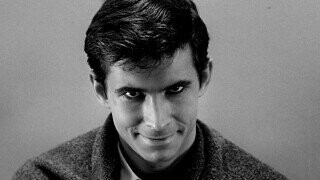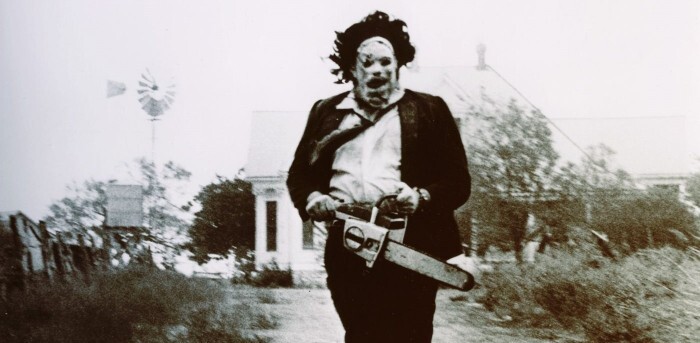Ed Gein: The Real Horror Behind the Scariest Movie Slashers

Psycho, The Texas Chainsaw Massacre, and Silence of the Lambs may not appear to have much in common with each other beyond making you pee your pants at various points of your life. They were made decades apart, their violence level ranges from “implied” to “chainsaw,” and their villains range from “mild mannered” to “coercive skin care.” Those villains were all inspired by the same guy, though: Ed Gein, A.K.A. the Butcher of Plainfield, a Wisconsin handyman with mommy issues and a penchant for DIY interior design.
Building Bates

(Paramount Pictures)
Like the characters inspired by him, Gein lived for most of his life in an isolated farmhouse in Plainville, Wisconsin, with a passive alcoholic father and domineering, fanatically religious mother who demanded absolute loyalty from her two sons. She was pretty disappointed with her lot in life, having shackled herself to a man she considered a “loser,” and she was determined to shield her boys from the outside world lest they become losers too, scolding them if they tried to make friends and teaching them that having sex with other women would be a betrayal to her. Strangely, this backfired.
He Probably Killed His Brother

After their father died in 1940 and the thirtysomething Henry and Ed Gein had no choice but to seek more work outside the home, Henry started dating a divorced woman and voicing his concerns about his brother’s attachment to their mother a little louder. Shortly thereafter, Ed claimed his brother went missing during a brush fire on the property but led police straight to his unburnt, beaten body. Henry Gein’s death was officially declared an accident, but probably only because no one knew what Ed Gein was willing to do for his mother yet.
A Boy’s Best Friend is His Mother
Gein got his mother all to himself for about a year before she died too and he went a little mad. He boarded up her bedroom and parlor while letting the rest of the house fall to squalor, moved into a little room near the kitchen, and spent his time studying Nazi medical experiments, human anatomy, horror novels, and lots and lots of porn. If that was as far as it went, no one could blame him for celebrating his freedom with a massive jerk-for-all, but it wasn’t, and he didn’t consider it freedom.
He Was Mostly a Graverobber

Two years after his mother died, Gein began making nocturnal expeditions to local graveyards “in a daze” in search of recently buried women who looked like his mother to … do whatever with. He later told police that he’d done this as many as 40 times, and it’s believed that this is where most of his “collection” came from.
Mary Hogan
Unlike his fictional avatars, Gein was no serial killer -- he was only officially linked to two murders. The first was in 1954, when he shot Mary Hogan, the owner of a tavern he frequented, before pulling her body home in a sled. Gein insisted his only other murder was an accident and never provided a satisfactory explanation for Hogan’s death, claiming to have no memory of it. He probably thought she had crazy, masturbation-forbidding eyes.
Bernice Worden
He didn’t kill again until 1957, when he visited Bernice Worden’s hardware store, asked her on a date (which she correctly turned down), then promised to return the next day for a gallon of antifreeze. Twenty-four hours later, her store was abandoned and covered in blood. Gein later told a psychiatrist that she had been accidentally shot while he examined a gun in her store, but at that point, most people call the police, not … well, you’ll see.
He Messed With the Wrong Old Lady

Unfortunately for Gein, Worden’s son was a deputy sheriff, and he was pretty invested in finding out what happened to her. He determined that the last receipt his mom had written had been for Gein’s antifreeze, so he sent police out to Gein’s farmhouse who were the least prepared for what they found. In addition to Worden’s body, which had been decapitated and hung by her ankles for carving, they found human organs in the refrigerator, a heart on the stove, and soup bowls made out of skulls. And that was just the kitchen.
Yeah, There Were Skin Suits
Gein’s collection included a corset, leggings, and masks made from human skin. He later explained to the police that he’d been making a “woman suit” so that he could become his mother, to which they responded, “Ah, okay. Makes perfect sense! Nothing weird going on here!”
And Furniture, Too
Gein was a particularly industrious graverobbing cannibal. He also had chairs and a trash bin made of skin, a nipple belt, a curtain drawstring made of lips, and most famously, a face lamp. Had he been born half a century later and been, you know, normal, he could have made a fortune in custom furniture.
The Trial of Ed Gein

Gein was held for 10 years without trial, having been declared too insane to try, until he was found not guilty of Worden’s murder by reason of insanity in 1968 and indefinitely committed. Prosecutors didn’t bother trying him for Hogan’s murder even though police found her face and skull (yes, separately) in his home, because like, why bother? He was never getting out. Why waste the taxpayers’ money?
The End of the House of Horrors

Meanwhile, Gein’s farmhouse, dubbed the “house of horrors” by the media, was set to go up for auction on March 30, 1958, when it was expected to be bought by an entrepreneur who wanted to turn it into a tourist attraction. Local residents weren’t terribly pleased about that, but “Eh, what can we do?” they all sighed, shrugging animatedly. Incidentally, the house burned down a few days before the auction in a mysterious fire that nobody ever bothered to investigate.
Psycho

(Paramount Pictures)
Writers who heard about Gein were like, “Geez, I can not do better than that,” and wasted no time capitalizing on his crimes. Robert Bloch published Psycho in 1959, and Hitchcock’s assistant brought him the story after reading a review of the novel. He eventually bought up as many copies as he could to prevent audiences from finding out the twist, but everyone in Plainville already knew Mrs. Bates was dead.
The Texas Chainsaw Massacre

(Bryanston Distributing Company)
1974’s The Texas Chainsaw Massacre claims to be a true story, and while that’s an act of misinformation meant to mirror that of the government (you know how filmmakers like to get all themey), the story does contain elements of real-life crimes, including Gein’s. Chiefly, director Tobe Hooper thought it would be scarier if people couldn’t see the killer’s face, and what scarier way to hide someone’s face than with a mask of human skin?
The Silence of the Lambs

(MGM)
As you may have noticed, Thomas Harris, writer of the Hannibal Lecter series of books, was into criminal psychology, so much so that he regularly sat in on classes at the FBI Academy, because that’s something you can do when you’re a world-famous author. That’s where he learned about Ed Gein, who became one of three real-life killers who influenced the woman-suit-obsessed Buffalo Bill. (The other two were Gary Heidnik and Ted Bundy, the latter of whom also influenced the creation of Hannibal Lecter by helping police track down the Green River Killer. It was Bundy catching Bundy.)
The Death of Leatherface

Meanwhile, Gein was reported to be a “model patient” at the Mendota Mental Health Institute, never causing any trouble beyond staring excessively at the incredibly underpaid nurses. He died of cancer there on July 26, 1984 at the age of 77. It’s unclear whether he ever saw any of the movies based on his crimes, but even he would have to admit that Hitchcock crushed it.
Top image: Paramount Pictures